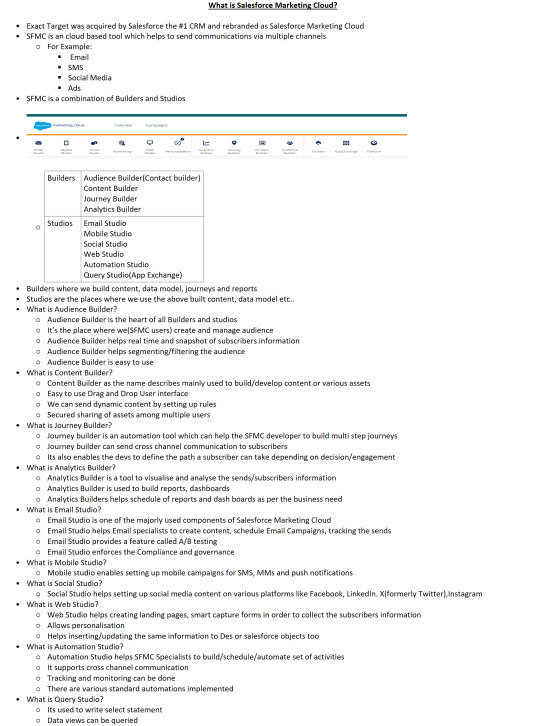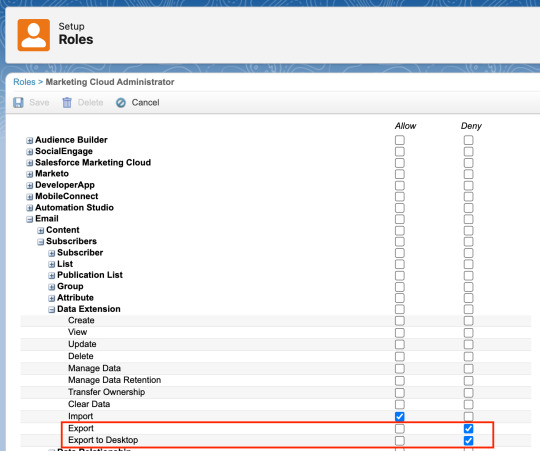#marketing cloud
Explore tagged Tumblr posts
Text
Big news for small businesses! Salesforce unveils Marketing Cloud Growth, empowering SMBs with powerful tools to boost their marketing efforts and scale their businesses.
Say hello to smarter strategies and accelerated growth!
2 notes
·
View notes
Text
Salesforce Marketing Cloud Introduction

Thanks so much for reading , would love to have the feedback.
2 notes
·
View notes
Text
Salesforce has announced Marketing Cloud Next, its powerful agentic marketing solution designed to transform customer engagement. With AI-powered automation, real-time data from Data Cloud, and intelligent AI agents, it enables marketers to launch personalized, responsive campaigns faster than ever. This marks a major shift from static messaging to dynamic, two-way conversations across every marketing channel.
1 note
·
View note
Text
From journey mapping to audience segmentation, Salesforce Marketing Cloud offers a complete suite to elevate your marketing strategy. Discover how it boosts performance.
0 notes
Text
Salesforce Marketing Automation Consulting Company - Cymetrix

Finding it hard to achieve marketing success with manual, disjointed campaigns that drain resources and dilute ROI? Inefficient workflows, siloed data, and generic messaging plague businesses lacking tools like Salesforce for marketing automation. Cymetrix transforms this chaos into precision. As certified experts, they design end-to-end automation strategies—leveraging tools like Marketing Cloud Account Engagement (Pardot) and Marketing Cloud—to unify lead nurturing, email campaigns, and CRM synchronization.
They can help automate lead scoring to prioritize high-value prospects, trigger personalized journeys based on real-time behavior (e.g., abandoned carts, webinar attendance), and align sales-marketing handoffs via seamless CRM integration. For businesses drowning in manual tasks, Cymetrix scales efficiency: deploy dynamic content, segment audiences intelligently, and track engagement across channels—all while maintaining compliance. Stop letting gaps in automation stifle growth. Partner with them to turn Salesforce marketing automation into your engine for hyper-personalized, scalable marketing that converts.
#cymetrix software#salesforce#cymetrix salesforce#marketing automation agency#marketing#marketing cloud#salesforce marketing cloud
0 notes
Text
Restrict Exporting Data From Salesforce Marketing Cloud
Salesforce Marketing Cloud (SFMC) is a powerful platform for managing campaigns, and it involves accessing sensitive customer data and a lot of transaction data. Securing this data from unauthorized exports is critical for compliance, privacy, and risk mitigation. Uncontrolled data extraction can lead to data breaches, GDPR/CCPA violations, and insider threats. In this post, we’ll explore…

View On WordPress
#data extension remove export button#disable data export#disable data export from marketing cloud#disable data export from sfmc#Marketing Cloud#restrict data export#Salesforce blog#salesforce disable data export#sfdc fanboy#sfdcFanBoy
0 notes
Text
Marketing Cloud vs Pardot : Which One is Right For You?

Salesforce offers two prominent marketing automation platforms: Marketing Cloud and Pardot (recently rebranded as Marketing Cloud Account Engagement). Choosing the right platform depends on your business's specific needs and target audience.
Marketing Cloud is a comprehensive solution designed for B2C companies aiming to engage with a vast consumer base. It provides tools for email marketing, social media engagement, advertising, and customer journeys, enabling businesses to deliver personalized experiences across multiple channels. This platform is ideal for organizations focusing on large-scale consumer outreach and real-time interactions.
Pardot, now known as Marketing Cloud Account Engagement, caters to B2B companies that require robust lead nurturing capabilities. It offers features like lead scoring, ROI reporting, and advanced analytics, assisting businesses in building meaningful connections and generating high-quality leads. Pardot is particularly suited for aligning marketing and sales teams to engage with potential clients over longer sales cycles.
In summary, if your business targets individual consumers and emphasizes broad, multi-channel campaigns, Marketing Cloud may be the appropriate choice. Conversely, if your focus is on engaging other businesses with a need for detailed lead management and nurturing, Pardot could be more suitable.
For a more in-depth comparison, please visit the original blog post: Marketing Cloud vs. Pardot: Which One Your Business Needs?
0 notes
Text
#salesforce#salesforce cloud#CRM#CRM platform#customer service#Features of Salesforce#manage customer interactions#Service Cloud#Marketing Cloud#Commerce Cloud#Einstein AI#Analytics Cloud#Community Cloud#Mobile App#Operational Efficiency#Scalability#Security
0 notes
Text
How to maximize Salesforce Data Cloud credits in Marketing Cloud Growth Edition. Learn tips to optimize data usage, enhance campaigns, and drive impactful marketing results.
0 notes
Text
Project Go-Live: Salesforce CG Cloud
Our new Salesforce CG Cloud project is up and running! It’s a big success for our digital-first retail client, helping them connect better with customers and increase engagement. Great job to our team for making it happen! Ready to learn how we can do the same for you? Contact us today!" https://www.kvpcorp.com/
0 notes
Text
WHY ARE BUSINESSES INVESTING IN CUSTOMER EXPERIENCE?
#sales#salesforce#marketing#ad#advertising#customerexperience#salesforce partner#solunus#marketing cloud
0 notes
Text
SALESFORCE - SPARK TECHNOLOGIES
We design, develop, implement, manage and optimize access to systems and information to answer your business processing, application and infrastructure needs. Whether you are a private or public sector organization, or whether you want to run our solutions on your own hardware, or outsource your IT through us, Spark Technologies has the expertise you need to overcome the business challenges you face.

1 note
·
View note
Text
#salesforce consulting#nube transfer#salesforce marketing cloud#marketing cloud#salesforce partner#salesforce crm#fexle services#crm software#content transfer#salesforce implementation
0 notes
Text
SALESFORCE-SPARK TECHNOLOGIES
We design, develop, implement, manage and optimize access to systems and information to answer your business processing, application and infrastructure needs. Whether you are a private or public sector organization, or whether you want to run our solutions on your own hardware, or outsource your IT through us, Spark Technologies has the expertise you need to overcome the business challenges you face.
0 notes
Text
Cymetrix: Salesforce Marketing Cloud Consultants in India

Looking to maximize ROI from your Salesforce Marketing Cloud investment in India? Siloed data, inconsistent campaigns, and underutilized automation tools often dilute its potential. As trusted Salesforce Marketing Cloud consultants in India, Cymetrix bridges this gap with tailored solutions—from seamless platform implementation to AI-driven strategy optimization.
They unify fragmented customer data (email, SMS, social) into cohesive journeys, automate personalized campaigns using Einstein AI, and integrate CRM workflows to align sales and marketing. Whether scaling B2C engagement, refining loyalty programs, or troubleshooting complex setups, our expertise ensures you leverage every feature—Journey Builder, Email Studio, Advertising Studio—to its fullest.
For Indian businesses, they prioritize local market nuances, compliance, and cost efficiency, transforming Marketing Cloud from a tool into a growth engine. Stop settling for surface-level results—partner with Cymetrix to turn data into loyalty, clicks into conversions, and challenges into competitive advantages.
#cymetrix software#salesforce#cymetrix salesforce#marketing cloud#salesforce marketing cloud#marketing
0 notes
Text
Salesforce Marketing Cloud Solutions for Any Size Business
Whether running a small business or managing a larger enterprise, the Salesforce Marketing Cloud has something in store for you. The powerful platform was designed to help businesses of all sizes easily connect with their customers through personalized marketing interactions at scale. Offering tools for social media, email, advertising, and customer engagement, the Marketing Cloud allows you to…
#Customer Journey Mapping#Email Marketing Automation#Lead Scoring and Nurturing Salesforce#Marketing Cloud#Marketing Cloud AI#marketing cloud for enterprise#Marketing Cloud for Small Business#marketing cloud for smb#Marketing Cloud Personalization#Marketing Cloud Security Compliance#Marketing for Medium Sized Enterprises#Salesforce AI#Salesforce blog#Salesforce Marketing Cloud Solutions for Any Size Business#sfdc fan boy#sfdcFanBoy
0 notes